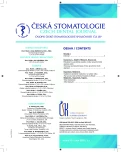Tilted Implants
Authors:
A. Šimůnek 1; D. Kopecká 1; L. Čapek 2
Authors‘ workplace:
Stomatologická klinika LF UK a FN, Hradec Králové
1; Technická univerzita v Liberci, Katedra mechaniky, pružnosti a pevnosti, Liberec
2
Published in:
Česká stomatologie / Praktické zubní lékařství, ročník 115, 2015, 1, s. 18-24
Category:
Review Article - Practical Report
Overview
Introduction and aim:
The authors discuss tilted dental implants. They define the tilted and the vertical implants, and they draw attention to biomechanical advantages, which the tilted implants bring.
The first presumption of the effectivity of tilted implants is their high resistance to extra-axial occlusal loading. However, former papers based on photoelastic models, finite element analyses or clinical studies have proved this surprisingly high resistance.
Results:
Four indication groups are defined and they are illustrated by implantological cases. The most important indication of the tilted implants is the edentulous jaw in connection with the All-on-4 and All-on-6 concepts.
Conclusions:
The authors reveal that there is not any reason for the insertion of the vertical implants. The rationally disparallel implants are more effective. However, this trend is not followed enough in the Czech implantological practice. A definitive evaluation of the effectivity of the tilted implants will be provided on the basis of long-term clinical experience.
Keywords:
dental implants – cantilever – tilted implants – vertical implants
Sources
1. Ata-Ali, J., Penarrocha-Oltra, D., Candel-Marti, E., Penarrocha-Diago, M.: Oral rehabilitation with tilted dental implants: A metaanalysis. Med. Oral Patol. Oral Cir. Bucal, roč. 17, 2012, č. 4, s. 582–587.
2. Baggi, L., Pastore, S., Di Girolamo, M., Vairo, G.: Implant-bone load transfer mechanisms in complete-arch prostheses supported by four implants: A three-dimensional finite element approach. J. Prosth. Dent., roč. 109, 2013, č. 1, s. 9–21.
3. Bevilacqua, M., Tealdo, T., Menini, M., Pera, F., Mossolov, A., Drago, C., Pera, P.: The influence of cantilever length and implant inclination on stress distribution in maxillary implant-supported fixed dentures. J. Prosth. Dent., roč. 105, 2011, č. 1, s. 5–13.
4. Bevilacqua, M., Tealdo, T., Pera, F., Menini, M., Mossolov, A., Drago, C., Pera, P.: Three-dimensional finite element analysis of load transmission using different implants inclinations and cantilever lengths. Int. J. Prosthodont., roč. 21, 2008, č. 6, s. 539–542.
5. Fortin, T., Isidori, M., Bouchet, H.: Placement of posterior maxillary implants in partially edentulous patients with severe bone deficiency using CAD/CAM guidance to avoid sinus grafting: A clinical report of procedure. Int. J. Oral Maxillofac. Implants, roč. 24, 2009, č. 1, s. 96–102.
6. Chen, Z. X., Wang, C., Wang, L. J.: Three-dimensional finite element analysis of tilted implants in the maxillary posterior region. Chinese J. Tissue Eng. Res., roč. 17, 1013, č. 33, s. 5957–5962.
7. Kim, K. S., Kim, Y. L., Bae, J. M., Cho, H. W.: Biomechanical comparison of axial and tilted implants for mandibular full-arch fixed prostheses. Int. J. Oral Maxillofac. Implants, roč. 26, 2011, č. 5, s. 976–984.
8. Kopecka, D., Simunek, A., Brazda, T., Rota, M., Slezak, R., Capek, L.: Relationship between subsinus bone height and bone volume requirements for dental implants: A human radiographic study. Int. J. Oral Maxillofac. Implants, roč. 26, 2012, č. 1, s. 48–54.
9. Malhotra, A. O., Padmanabhan, T. V., Mohamed, K., Natarajan, S., Elavia, U.: Load transfer in tilted implants with varying cantilever lengths in an all-on-four situation. Aust. Dent. J., roč. 57, 2012, č. 4, s. 440–445.
10. Maló, P., De Araújo Nobre, M., Lopes, A., Francischone, C., Rigolizzo, M.: All-on-4: Immediate-function concept for completely edentulous maxillae. A clinical report on the medium (3 years) and long-term (5 years) outcomes. Clin. Impl. Dent. Relat. Res., roč. 14, 2012, Suppl. 1, s. 139–150.
11. Monje, A., Chan, H. L., Suarez, F., Galindo-Moreno, P., Wang, H. L.: Marginal bone loss around tilted implants in compari-son to straight implants: A meta-analysis. Int. J. Oral Maxillofac. Implants, roč. 27, 2012, č. 6, s. 1576–1583.
12. Rapani, M., Rapani, C., Di Gregorio, G., Perrotti, V., Iezzi, G.: Impianti angolati nella pratica clinica. Ital. Oral Surg., roč. 11, 2012, Suppl. 1, s. 22–35.
13. Silva, C. G., Mendonca, J. A., Lopes, L. R., Landre, J.: Stress patterns on implants in prostheses supported by four or six implants: A three-dimensional finite element analysis. Int. J. Oral Maxillofac. Implants, roč. 25, 2010, č. 2, s. 239–246.
14. Šimůnek, A., a kol.: Dentální implantologie (druhé, přepracované a doplněné vydání). 1. vyd. Hradec Králové, Nucleus HK, 2008, s. 100. ISBN 978-80-87009-30-7.
15. Zampelis, A., Rangert, B., Heijl, L.: Tilting of splinted implants for improved prosthodontic support: A two-dimensional finite element analysis. J. Prosth. Dent., roč. 97, 2007, Suppl. 6, s. 35–43.
Labels
Maxillofacial surgery Orthodontics Dental medicineArticle was published in
Czech Dental Journal

2015 Issue 1
- What Effect Can Be Expected from Limosilactobacillus reuteri in Mucositis and Peri-Implantitis?
- The Importance of Limosilactobacillus reuteri in Administration to Diabetics with Gingivitis
Most read in this issue
- The Success Rate of Dental Implants in Elderly
- Contribution of the Digital Facebow and Individually Programmed Articulator in Removable Complete Dentures
- Molecular and Genetic Basis of Non-Syndromic Tooth Agenesis
- Tilted Implants
